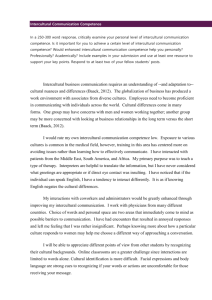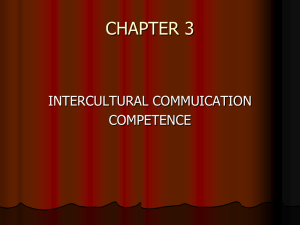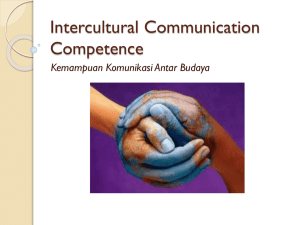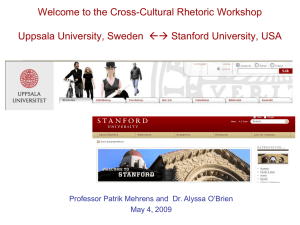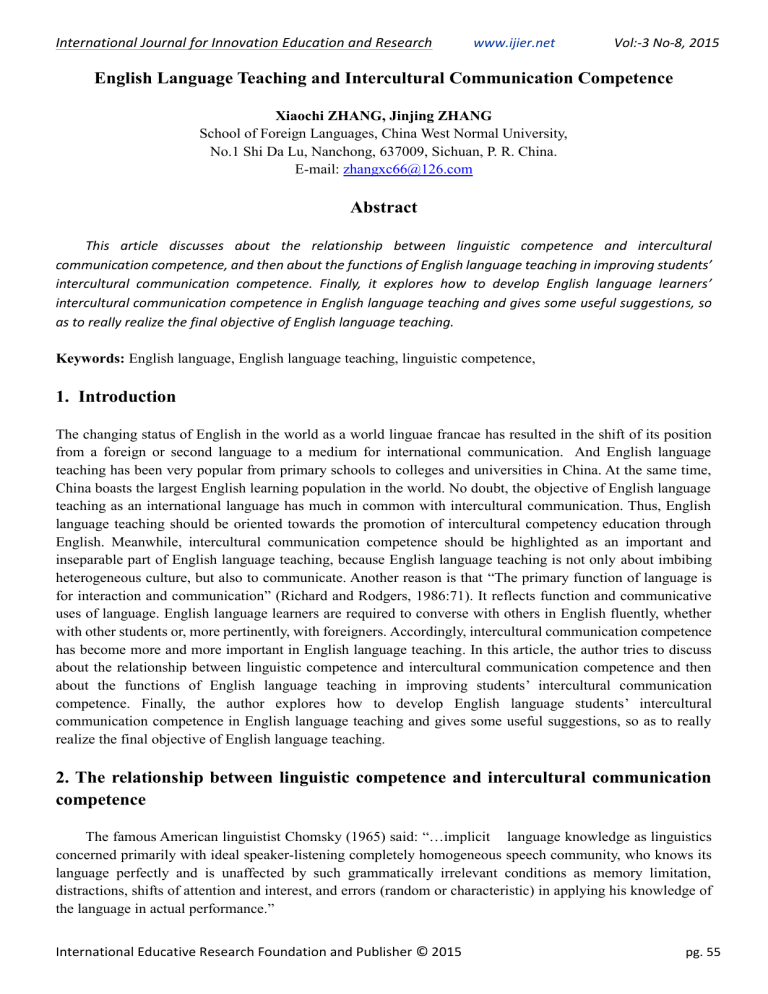
International Journal for Innovation Education and Research www.ijier.net Vol:-3 No-8, 2015 English Language Teaching and Intercultural Communication Competence Xiaochi ZHANG, Jinjing ZHANG School of Foreign Languages, China West Normal University, No.1 Shi Da Lu, Nanchong, 637009, Sichuan, P. R. China. E-mail: zhangxc66@126.com Abstract This article discusses about the relationship between linguistic competence and intercultural communication competence, and then about the functions of English language teaching in improving students’ intercultural communication competence. Finally, it explores how to develop English language learners’ intercultural communication competence in English language teaching and gives some useful suggestions, so as to really realize the final objective of English language teaching. Keywords: English language, English language teaching, linguistic competence, 1. Introduction The changing status of English in the world as a world linguae francae has resulted in the shift of its position from a foreign or second language to a medium for international communication. And English language teaching has been very popular from primary schools to colleges and universities in China. At the same time, China boasts the largest English learning population in the world. No doubt, the objective of English language teaching as an international language has much in common with intercultural communication. Thus, English language teaching should be oriented towards the promotion of intercultural competency education through English. Meanwhile, intercultural communication competence should be highlighted as an important and inseparable part of English language teaching, because English language teaching is not only about imbibing heterogeneous culture, but also to communicate. Another reason is that “The primary function of language is for interaction and communication” (Richard and Rodgers, 1986:71). It reflects function and communicative uses of language. English language learners are required to converse with others in English fluently, whether with other students or, more pertinently, with foreigners. Accordingly, intercultural communication competence has become more and more important in English language teaching. In this article, the author tries to discuss about the relationship between linguistic competence and intercultural communication competence and then about the functions of English language teaching in improving students’ intercultural communication competence. Finally, the author explores how to develop English language students’ intercultural communication competence in English language teaching and gives some useful suggestions, so as to really realize the final objective of English language teaching. 2. The relationship between linguistic competence and intercultural communication competence The famous American linguistist Chomsky (1965) said: “…implicit language knowledge as linguistics concerned primarily with ideal speaker-listening completely homogeneous speech community, who knows its language perfectly and is unaffected by such grammatically irrelevant conditions as memory limitation, distractions, shifts of attention and interest, and errors (random or characteristic) in applying his knowledge of the language in actual performance.” International Educative Research Foundation and Publisher © 2015 pg. 55 Online-ISSN 2411-2933, Print-ISSN 2411-3123 July 2015 Conversely, Hymes (1972) thinks that linguistic competence is a competence that deals with affairs by using language, so he puts forward the concepts of communicative competence is a definition of what a speaker needs to know in order to be communicatively competent in a speech community. In Hymes’s view, a person with communicative competence acquires both knowledge and ability for language use regarding: 1)Whether (and to what degree) something is formally possible; 2)Whether (and to what degree) something is feasible by virtue of the means of implementation available; 3)Whether (and to what degree) something is appropriate (adequate, happy, successful) in relation to a context in which it is used and evaluated; 4)Whether (and to what degree) something is in fact done, actually performed, and what its doing entails. (Hymes 1972;281) In this sense, the notion of communicative competence, like the other aspects of culture and communication, is a diverse concept, which varies across cultures as a result of different levels of expected participation, different beliefs, different social situations, different types of knowledge, and different values and standards. With the above said, intercultural communication competence entails not only communicative competence in linguistic and pragmatic terms of the language used in the intercultural encounter, more importantly it demands awareness of different sets of cultural scripts and the ability to mediate between different cultural identities. Intercultural communication competence can be thus defined as a person’s ability to engage in productive intercultural dialogues of meanings and relationships with people from different cultural backgrounds. To make the intercultural interaction productive, one needs to have the ability to construct meaning and rapport with people from different cultural backgrounds through appropriate and effective use of verbal and nonverbal language. (Song, 2009) At the present, the contact and communication with people from different cultures is an important way to learn more about other people and their way of life, including their values, history, habits, and even the substance of their personality. As humans we all have the same basic desires and needs, we just have different ways of achieving them. As we learn this, we can develop a tolerance for difference. This can be accomplished only when we initiate relationships with people who are different from ourselves. Therefore, the goal of English language teaching should be to increase the students’ communicative competency skills, which would include not only linguistic competencies but also intercultural competence which has usually been set on trying to promote and facilitate communication across cultures. It is also quite clear that knowledge of intercultural communication can help to solve communication problems before they arise. Increased contact with other cultures in the contemporary world makes it imperative for us to understand and get along with people who may be vastly different from us. The increased awareness and understanding of other culture and people who may not share our views beliefs, values, customs, habits and lifestyles will eventually enhance our ability to coexist peacefully with people of other cultural backgrounds and to help resolve international conflicts. (Samovar, Porter & Stefani, 2000) 3. The functions of English language teaching in improving learners’ intercultural communication competence. From the above analysis of relationship between linguistic competence and intercultural communication competence, we may easily know that English language teaching itself is the practice of not only improving learners’ linguistic competence but also intercultural communication competence as the teaching of English language unavoidably involves the teaching of the cultures from English spoken countries. Moreover, English language teaching has a unique role to play in developing students’ linguistic competence and to help students broaden their mind, to absorb in foreign cultural essence and to finally improve learners’ intercultural communication competence. International Educative Research Foundation and Publisher © 2013 pg. 56 International Journal for Innovation Education and Research www.ijier.net Vol:-3 No-8, 2015 3.1 English language teaching has a crucial role in cultivating English language learner’ intercultural communication awareness Because face-to-face contact among people of different cultural backgrounds has increased in recent years, the world has become a shrinking interdependent one. (Chen, 2010) This is the reason why Sitaram and Cogdell (1976) proclaimed that “all the people of the world should study intercultural communication” (P.15. Sitaram and Cogdell’s sentiment is somewhat exaggerated, but it suggests the importance of learning more about people of other cultures. No doubt, intercultural communication is a common daily occurrence. The communication between cultures is happening continuously, with it taking place almost every day. Today, people may find thousands of students going abroad to study, millions of foreign travelers coming to China to visit, artists giving performances in different countries and many joint venture enterprises doing business in many of our cites in China. Intercultural communication is prevalent today. (Chao, 2011) Owing to the involvement of cultural factors, the study of intercultural communication competence becomes much more complicated. Basically, intercultural communication competence indicates: a) ability to communicate interpersonally, (b) ability to adjust ot different cultures, (c) ability to adjust to different cultures, (c) ability to deal with different societal systems, (d) ability to to establish interpersonal relationships and (e)ability to understand others. Thus, persons with intercultural communication competence must no only know how to interact effectively and appropriately with people of different cultures and different environment of different countries abut also know how to fulfill their own communication goals by respecting and affirming the multi-level cultural identities of the interactants. At the same time, English language has become an international language. English language is always used by different people from different cultural and linguistic backgrounds to express their ideas and opinions. When English language teaching is used by diverse people from diverse cultural backgrounds, the diverse values, beliefs, world views, ways of thinking, and patterns of life embedded in the linguistic forms and the manner by which the selected linguistic forms are put into speech or text, can also be brought to the intercultural communication awareness of the students. 3.2 English language teaching is an important channel for improvement of the students’ intercultural communication competence At first of all, English language teaching can provide the students opportunities to come into contact other cultures and people in the classrooms without going abroad, because the cultures in English-spoken countries are brought to the knowledge of the students through various English language teaching materials, class activities and personal interaction with foreign teachers and students from English –spoken countries. Needless to say, in the intercultural interaction through various types of English language teaching and English language learning, alternative ways of intercultural communication and ways of living (with their foreign language teachers) are unfolded and thus the ideology of cultural relativity will be gradually built up in the students with the enhancement of not only their intercultural communication awareness, but also their intercultural communication competence. To some extent, the process of English language teaching and learning is a process of intercultural communication between the students’ first linguaculture and the students’second linguacultures. Throughout the process, English language teachers and students are engaged in negotiation of definitions establishment or reestablishment of cultural identities in between their own linguaculture and that of others. English language teaching offers unique and important chances for the students’ intercultural experience and also makes the International Educative Research Foundation and Publisher © 2015 pg. 57 Online-ISSN 2411-2933, Print-ISSN 2411-3123 July 2015 students’ necessary experience of their personal growth into an intercultural person. In sum, English language teaching is the most effective means of cultivation for the students’ intercultural communication competence. Especially, English language has become an international language and been most widely used for intercultural communication all over the world. At the same time, English language learning has been a compulsory course in colleges and universities for most countries, the improvement and cultivation of intercultural communication competence through English language teaching can really benefit the largest number of the students than any other language teaching or any other language learning. Moreover, the students who learn and use English language will obtain the fundamental knowledge and skills for effective intercultural communication and successful career in an intercultural communicative world. 4. Some suggestions From the above discussion, English language teaching is recognized as the important functions such as a crucial role and an important channel in cultivation of the students’ intercultural communication competence. Now. it is necessary for us to explore that English language teaching for intercultural communication competence requires some measures and practices of English language teaching be set for the development of the students’ intercultural communication competence. Hence, the author gives some suggestions about how to improve the students’ intercultural communication competence through English language teaching. 4.1 Different colleges and universities in our country should change old syllabus and curricula which combine English language teaching with the knowledge of intercultural communication, so that students may not only learn English language but also master some basic knowledge and skills needed in intercultural communication. Now, English language is viewed as an international language and a means of intercultural communication for international interactions, affairs, business, and other fields. That is to say, teachers of English language should know the new goals of English language teaching through the new syllabus and curricula and pay much more attention to cultivating the students’ intercultural communication competence for their future various work environment of globalization in the world. 4.2 English language teachers should change their old traditional teaching concepts and methods and adopt new teaching concepts and methods such as teaching modes of MOOC, Mini course and flipped class. Especially, the teachers should organize different seminars or group discussions among teachers and students on the various cultural characteristics of different English-spoken countries in the world. In this way, the students would change their own old behavior and attitude stereotypes and enhance their intercultural communication awareness, foster greater sensitivity to different foreign cultural traits, really understand cultural difference and learn to tolerate different cultures, so as to cultivate themselves to have fundamental intercultural literacy in an intercultural context. 4.3 English language teachers should change their teaching contents and provide the students with more information resources in English language teaching materials on intercultural communication, give the students more different types of courses about literature, history, philosophy and sociology, art from English spoken countries. Meanwhile, English language teachers should require students according to their different English levels to see more English film or watch the English programs on T.V. In addition, English language teachers also should ask the students to read extensively, such as English stories, novels, dramas, plays, writings of science and technology, newspapers and journals. If students might do so, they could have intercultural communication competence to understand different cultures and to respect different cultures, different values and beliefs of other people. International Educative Research Foundation and Publisher © 2013 pg. 58 International Journal for Innovation Education and Research www.ijier.net Vol:-3 No-8, 2015 5. Conclusion English language teaching involves not only a set of grammar rules and lexical items, but also a set of social conventions governing language form and behavior within a communicative group. That is to say, English language teaching cultivates students’ linguistic competence, but also intercultural communication competence. As a result, English language teachers should know the relationship between linguistic competence and intercultural communication competence and understand English language teaching itself is the practice of not only improving students’ linguistic competence but also intercultural communication competence as the teaching of English language unavoidably involves the teaching of cultures from the English spoken countries. And also English language teaching has a crucial role to play in developing the students’ intercultural communication competence, which can help the students broaden their mind, to learn excellent cultures and absorb in excellent cultural essence from English spoken countries. In addition, the English language teachers should adopt some effective measures to cultivate the students’ basic knowledge and skills of intercultural communication, enhance the students’ intercultural communication awareness through various teaching modes, so as to realize the goal of English language teaching to cultivate the students’ intercultural communication competence. References Chen, Guoming. (2010). Foundations of Intercultural Communication Competence. Hongkong: China Review Academic Publishers Limited, 2p. Chen, Ruiming. (2011). Fundamentals of Intercultural Communication. Beijing: University of International Business and Economic’s Press, 3p. Chomsky, N. (1965). Aspects of the Theory of Syntax. Cambridge Mass.: MIT Press. Hymes, D. (1972). “Competence and Performance in Linguistic Theory”, in R. Huxley & E. Ingram (eds.) Language Acquisition: Models Bed Methods. New York: Academic Press, pp.3-23 Richards, J.C. & Rodgers, T.S. (1986). Cambridge University Press. Approaches and Methods in Language Teaching. Cambridge: Samovar, L.A., Porter, R.E. & Stefani, L.A. (2000). Communication Between Cultures. Beijing: Foreign Language Teaching and Research Press, 66-69;79-81. Saville-Troike, M. (1996/2001). The ethnography of communication. In McKay, S.L. & Hornberger, N. H. (Eds.), Sociolinguistics and Language Teaching. Shanghai: Shanghai FOREIGN LANGUAGE Education Press, 351-373. Song, Li. (2009). Teaching English as Intercultural Education Challenges of Intercultural Communication. Intercultural Communication Research. Vol.1., 268p. International Educative Research Foundation and Publisher © 2015 pg. 59


